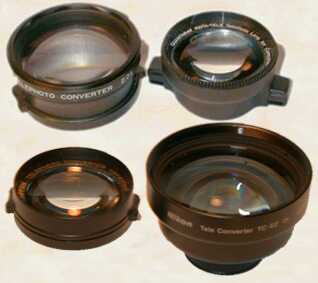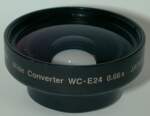Digital Camera Teleconverter and Wide-Angle Converter Comparison
 visitors since December 10, 1998
visitors since December 10, 1998
Updated June 19, 1999
 visitors since December 10, 1998
visitors since December 10, 1998
| If you want to extend or shorten the focal length of your digital camera you can usually add a teleconverter or wide angle converter to modify the camera's range. Teleconverters are add-on lenses that are screwed or snapped onto the camera and typically extend a camera's focal length by 1.25 - 2.0 times. Thus, using a 1.5x teleconverter, a camera with a focal length of 115mm would be boosted to 170mm. Similarly, a wide angle converter reduces the focal length of your digital camera. Using a 0.66x wide-angle converter with a camera with a 38mm minimum focal length reduces the focal length to 24mm.
This page contains my experiences with several different teleconverters, and one wide angle converter, with a Nikon 900 digital camera: A Quantaray 1.8x Insta-Tele Telephoto Lens for Camcorder, a Tiffen Digital Camera 2.0x, and a Tiffen Digital Camera 1.5x Telephoto Lens, a Nikon 2.0x teleconverter, and a 0.66x Nikon Wide Converter. I've also included a sample picture from a Raynox 2.0x teleconverter, although I have not used this lens. Tiffen lenses are available here, Quantaray lenses can be purchased from Ritz camera stores, and Nikon lenses are available here. |

Nikon 2.0x. The Nikon (model TC E2) is the clear winner in terms of image quality and focal length extension. None of the other lenses come close. The images are excellent, exhibiting none of the problems that are apparent with most other lenses. And, unlike most of the other lenses on this page, when Nikon says that their lens is a 2.0x, they really mean it. Most of the other lenses don't extend the focal length as much as their numbers indicate. When the camera is fully zoomed, this lens extends the focal length of the Nikon 900 and Nikon 950 cameras to a respectable 230mm equivalent. In fact, This lens is so good that you can add a second teleconverter to it and get even more extension. It can be used through most of the camera's zoom range, giving a useable range of about 110mm to 230mm. However, the image quality comes at a price...the lens is by far the largest and heaviest (its body is metal), and costs twice as much as any of the others, about $150. Nonethless, I'd highly recommend this lens.
Tiffen 1.5x. This lens produces images that are almost as good as the Nikon. There is very little color-fringing or blurring and images are quite sharp. However, this lens does not give nearly the same degree of magnification. Although it claims to be a 1.5x, it really only extends the focal length by about 1.25x. Thus, it will extend the focal length of the Nikon cameras to about 145mm. The lens is physically quite small, and can be used through most of the camera's zoom range. Vignetting only becomes apparent when the camera is set to its wide angle setting (although I'm not sure why you'd want to do this!) The lens costs about $60-$80.
Quantaray 1.8x. The Quantaray is smaller than the Tiffen 2.0x lens, and a little larger than the Tiffen 1.5x (the Quantaray is a little longer from front to back). I had to modify the Quantaray slightly to get it fit onto the camera by clipping off two small plastic arms designed to fit inside a video camera's lens housing. The image quality is OK, although blurring and color-fringing are visible near the edges of the images. And, it only extends the focal length by about 1.6x, not the 1.8x that it claims. The Quantaray cost about $30 and is the cheapest lens here.
Tiffen 2.0x. Despite the fact that the Tiffen 2.0x costs about twice as much as the Quantaray ($60-$80), I don't think the images it produces are any better. In fact, the Tiffen lens produces images that suffer from about the same amount of distortion, blur, and color-fringing near the edges. The only real difference is that the Tiffen is bigger, and allows you to use a wider-angle setting on the camera before vignetting becomes visible. And, like the Tiffen 1.5x and Quantaray, the Tiffen 2.0x does not extend the focal length as much as it claims. My tests indicate that it only extends the range by about 1.55 to 1.6x -- a little less than the Quantaray.
Raynox 2.0x. I can't say much about this lens because I have never used it. The picture below was kindly sent to me by another Nikon user. The image quality of the Raynox 2.0x looks reasonably comparable to the Tiffen 2.0x, but it is hard to make an exact comparison because of the different subject matter. The water and sky in the Raynox picture are not likely to show the same degree of color fringing and blurring that are evident in the trees and buildings in the other pictures. However, if you look closely at the buildings and trees at the edges of this picture you can see fairly obvious color fringing and blurring.

Nikon 0.66x. This is the only wide-angle (model WC-E24) I've reviewed and, like the Nikon teleconverter, it is an excellent lens. The images are very good, although not quite as good as those produced by the teleconverter. In a small number of the images I've taken (perhaps 10%), slight color fringing can be seen towards the edges of the images. However, it is very slight, and only occurs in images where there are areas of marked contrast near the edges. Most images look beautiful. The lens is physically as small as any of the teleconverters on this page, and is made of durable metal. With the wide angle converter attached, one can use the camera's entire zoom range without vignetting--giving the camera a 24-70mm equivalent focal range. It retails for about $100.
Click on the small images below to see the unmodified originals taken with a Nikon 900.
 Taken with Quantaray |
 Taken with Tiffen 2.0x |
Taken with Tiffen 1.5x |
|
Taken with Raynox 2.0x |
 Taken with Nikon 2.0x |
Taken with Nikon 0.66x |